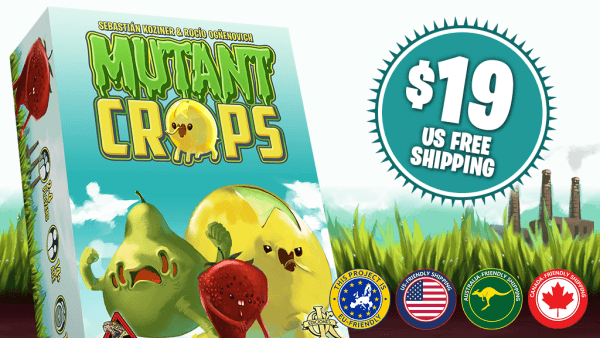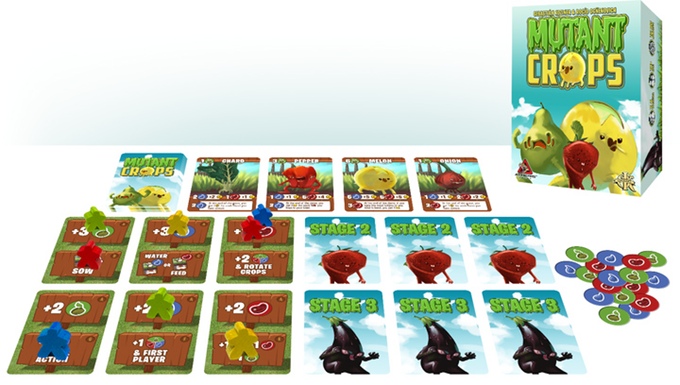Worker Placement for the Casual Gamer: An Inside Look at Mutant Crops

Developing a game is a personal journey, it is a story that unfolds for some over years of effort, networking, and sometimes just random chance. For developer Sebastián Koziner and publisher Andrew Birkett, that adventure has led to their recently released Kickstarter project for the simplified worker placement game, Mutant Crops. We sat down with both of them to learn a little more about how this game was created.
Jesse Tannous: I haven't seen many game projects advertised as being an "introductory worker placement game," what are the key differences between Mutant Crops and more traditional worker placement experiences?
Andrew Birkett: What's cool about Mutant Crops, and part of why Atheris Games is publishing it in English, is that the game is simple. There are not a lot of actions to take, but somehow there is still a great deal of strategy. The game focuses on three main resources: seeds, water, and steaks. The resources allow players to complete other actions. For example, seeds are used to get crops, and the other tokens are used to water and feed them, respectively.
As the turns progress more action cards are flipped so more actions are available later in the game, too. Therefore, the game is quick to start since there are relatively few actions and they are very straightforward. As the game progresses the actions become better and the choices more varied.
Sebastián Koziner: Well, the main difference for me is the length and the simplicity of the rules. Most of the good euros I play have a long setup, lots of pieces, and a considerable learning curve, that makes them hard to get you into them. I'm an Uwe Rosemberg fan, but I teach his worker placement games only to people that have played several of the games in my collection before.
With Mutant Crops, I wanted something that feels like a filler for the most experienced gamers, and to help them get their family to play Caverna without long faces. There are a lot of fun fillers out there, but what if I am in a euro/worker placement mood? Why should I play something different? We hope Mutant Crops fills that gap.

JT: Sebastián, you used to work in the video game industry, but have since focused your talents on creating tabletop gaming projects and graphic design. What motivated this career decision, and what are the key differences you've noticed in your work?
SB: Well, mainly because technology had taken giant steps since I worked in videogames, making some games on Game Boy Advance or my beloved DS, and I didn't enjoy the process anymore. Cellphones almost took over half of the industry’s efforts, and game design started to focus on selling the game instead of the gaming experience. Most of the games today feel more like a casino than a creative experience.
I've found it hard to connect with PC/console/mobile games after this greediness took over, and I felt that I had to either go indie or sell my soul, and didn't like any of the options. So, my hobby slowly became a career option.
Board games have this magical feel that even when you can feel betrayed because of that last huge game with endless expansions, still lots of good gaming experiences come out in small boxes from designers worldwide, and I fell in love with that spirit. I feel like I can do a real contribution for people to have fun with each other, to enjoy good gameplay, and I don't have to focus on squeezing their wallet, they can just buy a box and play with friends to enjoy. I'd rather squeeze their brains — it is a lot more fun.
JT: Which part of your job do you seem to enjoy more, creating artwork and graphic design elements for other game projects, or designing your own? Why?
SB: Both are very different experiences for me. I did art and graphic design for so long, that is the core of how I see myself working, it's just part of who I am, and I feel comfortable doing it. I also feel like I can help a project shine, and that feels amazing.
Game design, on the other hand, is something I’m new at. It challenges me, it makes me discover a new world, shakes my beliefs in what a game should or could be every time I try to come up with an idea, and that discovery is the most amazing feeling I can have.
So, I think that both parts are essential to me, something I feel comfortable with and something I feel excited with, a perfect mix in my opinion.
JT: Is the tabletop gaming industry a good place for artists and graphic designers looking for work? What can you tell me about that process, and how can others break into that market?
SB: Honestly, I still need to know more about the tabletop gaming industry, mostly because for the last 2 years, most of my works were with small studios and KS beginners, and I feel like that isn't a full spectrum yet. I'm still growing and my insights about the industry are still growing with me.
What I can say, is that as an artist and graphic designer, the board game world is as open and big as any other industry. Name a style, name a theme, and someone, somewhere, is wanting to make a game about it and you might help. That's amazing! I don't know if you will make tons of bucks on this as a job, but I’m sure creatively any artist could feel fulfilled in the right project.
But the community is huge, and there is an endless list of people wanting to do a game. If you want to break into the market, just go, talk to them, do some games with small profit just to have the experience, and I’m confident just that will open so much doors for you. It surely did for me.
JT: Andrew, what motivated your company Atheris Games to get behind Mutant Crops and attempt to publish an English version?
AB: Sebastián Koziner is an incredible designer and person. We've worked with him on several projects now including Cul-De-Sac Conquest, and two of our currently unpublished games: Holeshot Heroes and Supernatural Socks. We got in touch from a Facebook group we were in that allows publishers to find artists for tabletop games. He quickly made a card layout for Holeshot Heroes (the first game we worked on) to help us out and we commissioned him to finish all the graphic design for the game. When we pivoted the company to produce Cul-De-Sac Conquest it was a no-brainer to work with him again.
He was so great to work with, so when he presented the idea of publishing some of his games in English we were happy to look. We instantly loved Mutant Crops because its theme is quirky enough to fit our lineup. Though, we're very big on quality and were not looking to publish outside games so we let Sebastián know that if he sent a copy we would gladly look, but we could make no promises. When we got the game, we played it in the small retail store we operated at the time and everyone loved it. We knew that the beautiful artwork and great gameplay paired with our marketing/Kickstarter expertise and strict manufacturing standards would create a Kickstarter with a high likelihood of funding.
We're super excited to embark on this campaign with Sebastián!
[End of interview.]
For more information on Mutant Crops or some of the other games Koziner or Atheris Games are working on, make sure to visit the official Kickstarter campaign page.





Thanks so much for taking the time to interview us, Jesse!